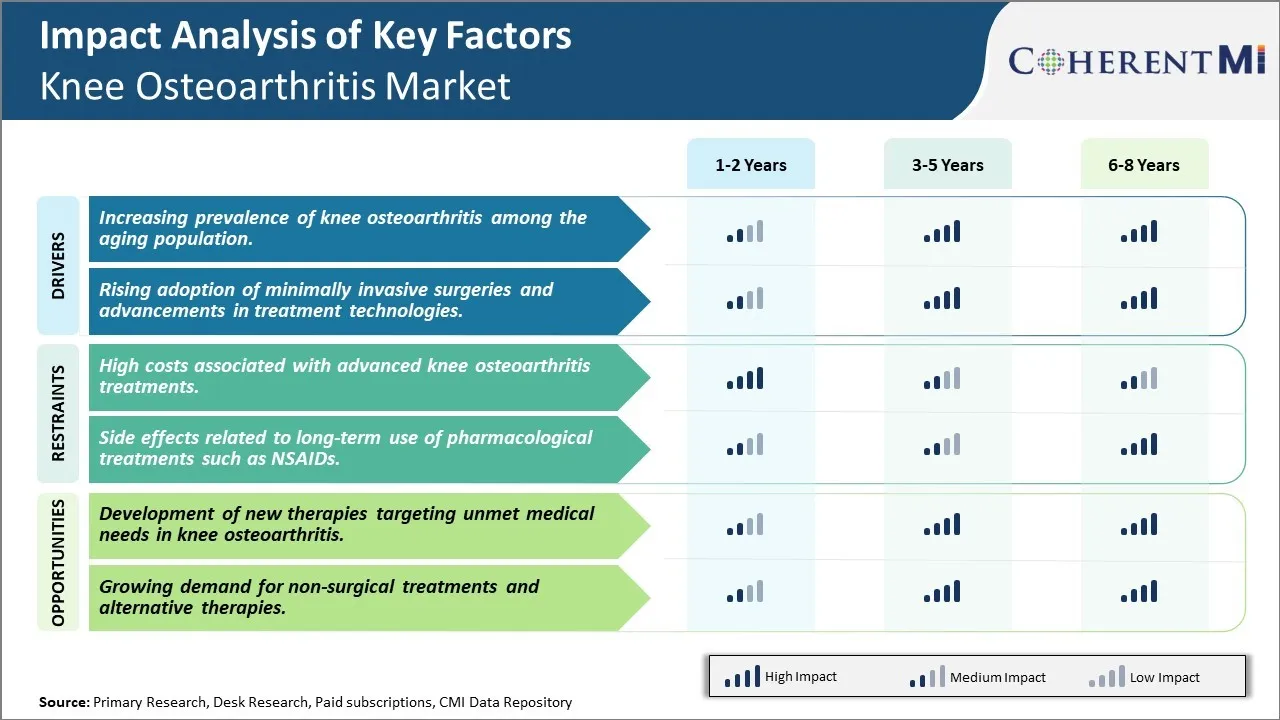Остеоартрит коленного сустава рынок АНАЛИЗ РАЗМЕРОВ И ДОЛЕЙ - ТЕНДЕНЦИИ РОСТА И ПРОГНОЗЫ (2024 - 2031)
Остеоартрит коленного сустава Рынок сегментируется по лечению остеоартрита коленного сустава (фармакологическое управление, нефармакологическое управл....
Остеоартрит коленного сустава рынок Тенденции
Рыночный драйвер - Увеличение распространенности остеоартрита коленного сустава среди стареющего населения
Поскольку продолжительность жизни растет во всем мире, население быстро стареет во всем мире. Популяция гериатрических больных в возрасте 65 лет и старше растет беспрецедентными темпами. По оценкам, к 2050 году во всем мире 1 из 6 человек будет в возрасте 65 лет и старше. С возрастом ткани в организме, включая хрящ, начинают изнашиваться естественным образом. Остеоартрит коленного сустава преимущественно влияет на эту стареющую популяцию, поскольку хрящ становится тонким и даже со временем изнашивается, что приводит к тому, что кости трется вместе, вызывая боль, отек и скованность. Пожилой возраст является самым большим фактором риска остеоартрита коленного сустава.
По мере того, как кости и хрящ в коленях подвергаются дегенеративным изменениям, возникает легкая и сильная боль и ограничение движения. Простые ежедневные задачи, такие как ходьба, подъем по лестнице, коленопреклонение и т. д., становятся трудными. Это значительно снижает качество жизни у пожилых людей. Отсутствие достаточной физической активности еще больше ускоряет дегенеративное состояние колена. Сидячий образ жизни широко распространен в развитых странах, особенно там, где большинство пожилых людей ведут все более неактивную жизнь. Продвинутая диагностика с помощью рентгеновских лучей показывает костные шпоры и потерю суставного пространства в коленях, пораженных остеоартритом. Во многих случаях операции по замене суставов являются единственным решением для облегчения боли и восстановления подвижности.
Рыночный драйвер - растущее внедрение минимально инвазивных операций и достижения в технологиях лечения
За последнее десятилетие произошли крупные технологические скачки в хирургических процедурах и медицинских устройствах для лечения остеоартрита коленного сустава. Минимально инвазивные методы, такие как артроскопия, становятся все более популярными по сравнению с традиционными операциями по замене коленного сустава, которые включают большие разрезы. Артроскопия облегчает диагностическую оценку проблем с коленом через крошечные разрезы и камеры, вставленные в сустав. Он также позволяет проводить такие процедуры, как удаление рыхлых костных или хрящевых лоскутов, обезжиривание областей, воспаленных артритом, и восстановление разорванных связок или мениска с минимальными простоями.
Кроме того, новые процедурные инновации улучшают результаты реабилитации после операций по замене коленного сустава. Роботизированные процедуры способствуют повышению точности по сравнению с ручной имплантацией протезов коленей. Сопоставленные или настроенные имплантаты пациента на основе 3D-изображений и методов печати анатомии колена каждого человека обеспечивают наилучшее соответствие и структуру заменяющих компонентов. Предварительные варианты биологического лечения с участием мезенхимальных стволовых клеток, богатой тромбоцитами плазмы и добавок направлены на снижение воспаления, замедление прогрессирования заболевания и восстановление поврежденного хряща. Носить стойкие материалы в протезировании нового поколения предназначены для более длительного использования. Системы удаленного цифрового мониторинга также позволяют осуществлять совместное наблюдение и раннее обнаружение послеоперационных проблем в домах пациентов посредством беспроводной передачи данных датчиков. В совокупности эти клинико-технологические факторы подпитывают рост лечения остеоартрита коленного сустава, стремящегося к поведению.

Вызов рынка - высокие затраты, связанные с передовыми методами лечения остеоартрита коленного сустава
Одной из основных проблем, с которыми сталкивается рынок остеоартрита коленного сустава, является высокая стоимость лечения пациентов с тяжелым остеоартритом коленного сустава. Растущие расходы на операции по замене суставов, такие как замена коленного сустава, сделали его недоступным для многих пациентов. Операция по замене коленного сустава считается одной из самых дорогих ортопедических процедур, а средняя общая стоимость операции по замене коленного сустава составляет от 30 000 до 60 000 долларов США. Кроме того, передовые варианты лечения, такие как биологические препараты, которые нацелены на воспаление, также поставляются с очень высокими ценами, что ограничивает их использование. Например, инъекции противовоспалительных биологических препаратов, таких как внутрисуставная гиалуроновая кислота, варьируются от 500 до 2000 долларов США за лечение, требуя многократных доз для эффективности. Финансовое бремя такого дорогостоящего лечения часто отпугивает пациентов от прохождения процедуры или терапии, что приводит к задержке лечения и ухудшению состояния здоровья. Это существенное экономическое бремя создает значительные проблемы для роста на рынке остеоартрита коленного сустава.
Возможности рынка - Разработка новых методов лечения, направленных на неудовлетворенные медицинские потребности при остеоартрите коленного сустава
Одна из основных возможностей для роста на рынке остеоартрита коленного сустава заключается в разработке новых методов лечения, которые могут удовлетворить некоторые неудовлетворенные медицинские потребности в лечении остеоартрита коленного сустава. В настоящее время доступные фармакологические методы лечения имеют ограниченную эффективность в изменении прогрессирования заболевания и в основном обеспечивают симптоматическое облегчение. Кроме того, операции по замене суставов являются высокоинвазивными вариантами, рассматриваемыми только для конечной стадии заболевания. Это оставляет значительную потребность в разработке модифицирующих болезнь методов лечения, которые могут замедлить ухудшение хряща и улучшить здоровье суставов. Компании активно инвестируют в исследовательские усилия по изучению новых методов лечения, таких как генная терапия, клеточная терапия и тканевые решения, которые потенциально могут восстановить поврежденный хрящ. Успех таких новых вариантов лечения в клинических испытаниях откроет выгодные перспективы роста, предлагая минимально инвазивные решения для пациентов на ранних стадиях заболевания. В целом, существенные неудовлетворенные потребности в управлении основной патологией остеоартрита представляют собой важную коммерческую возможность для фармацевтических компаний и производителей устройств на рынке остеоартрита коленного сустава.